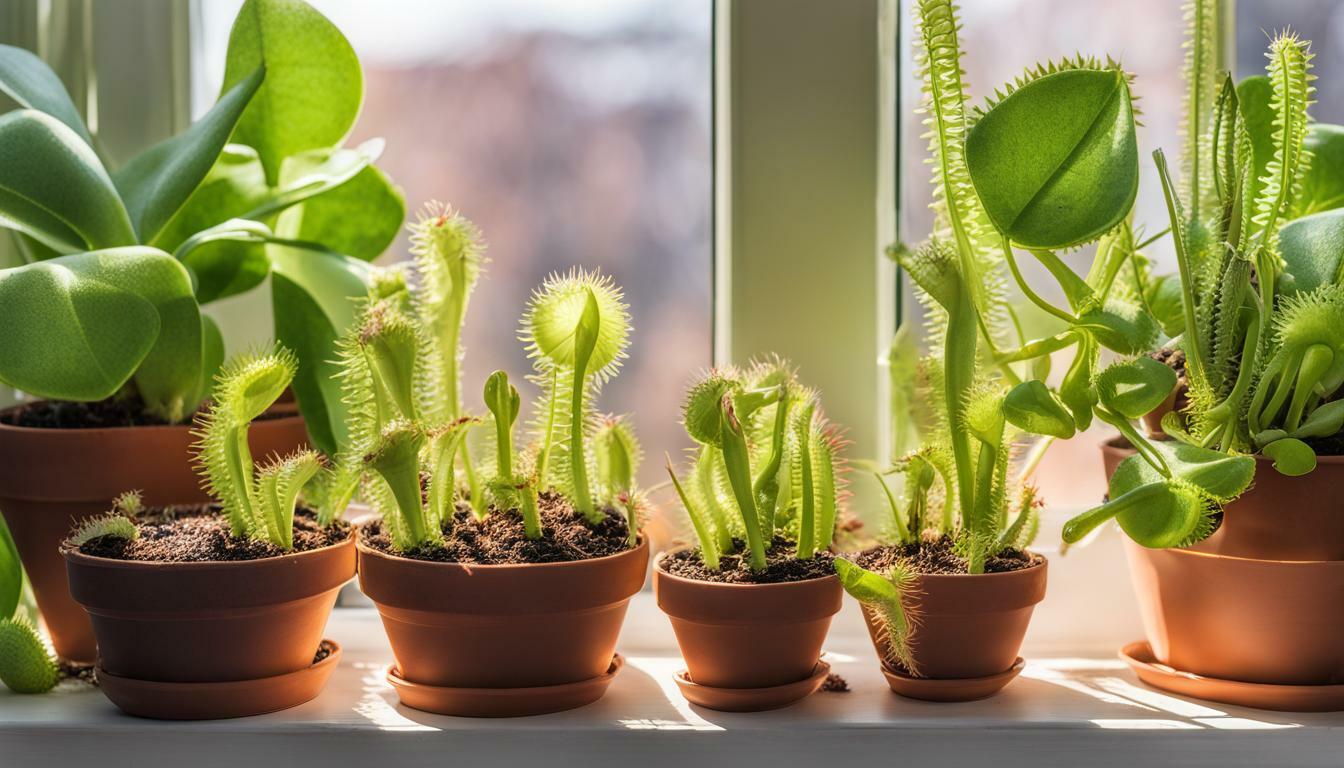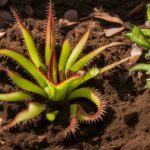If you’re a plant enthusiast, you are probably familiar with the Venus flytrap, a unique carnivorous plant that catches and digests insects. While these plants are fascinating in themselves, there is another aspect of their growth that is equally compelling: propagation. Knowing how to propagate Venus flytraps is essential for maintaining their populations and ensuring a healthy and diverse collection of these fascinating plants.
In this article, we will explore the various methods of propagating Venus flytraps, including division, leaf cuttings, seed germination, and rhizome division. We will provide step-by-step instructions and care tips for each method, enabling you to become a pro at Venus flytrap propagation. Let’s get started!
Key Takeaways
- Effective propagation methods are crucial for maintaining healthy Venus flytrap populations.
- There are various methods of propagating Venus flytraps, including division, leaf cuttings, seed germination, and rhizome division.
- Each propagation method requires specific care practices to ensure success.
Understanding Venus Flytrap Propagation Methods
If you’re interested in propagating Venus flytraps, there are several methods to choose from. Each method has its advantages and disadvantages, and some are more challenging than others. Here are the four main propagation methods:
Venus Flytrap Division
Division is one of the most reliable and straightforward methods of propagating Venus flytraps. It involves separating the plant into smaller parts, each of which can grow into a separate plant. You should only attempt division when the plant has outgrown its current pot or if you notice dead or damaged leaves or roots.
To divide a Venus flytrap, carefully remove it from its pot and gently separate the roots. Each new plant should have at least one “trap” and several roots. Repot each new plant in a pot with fresh soil and water it well.
Venus Flytrap Leaf Cuttings
Leaf cuttings are another effective propagation method for Venus flytraps. This method involves taking a leaf petiole (the stem that connects the leaf to the plant) and encouraging it to grow roots and a new plant.
First, select a healthy leaf and cut the petiole about a half-inch from the base of the plant. Remove all the leaves except for the top two. Fill a small pot with a mixture of peat moss and perlite, and insert the petiole about an inch deep into the soil. Water the soil and cover the pot with a clear plastic bag to retain moisture.
After a few weeks, new plants should begin to grow from the base of the petiole. Remove the plastic bag and continue to care for the new plant as you would a mature Venus flytrap.
Venus Flytrap Seed Germination
Germinating Venus flytrap seeds can be a little more challenging than other propagation methods, but it’s a great way to start completely new plants. Collect the seeds in the fall after they have turned brown. Store them in a cool, dark place until you’re ready to plant them in the spring.
Fill a small pot with a mixture of peat moss and perlite and sprinkle the seeds on top. Cover the pot with a clear plastic bag to create a greenhouse effect and place it in a bright, warm location. Keep the soil moist but not waterlogged.
After a few weeks, the seeds should begin to germinate. Once the seedlings are large enough to handle, transplant them into individual pots filled with a peat moss and perlite mixture.
Venus Flytrap Rhizome Division
This advanced method of propagation involves dividing the underground stem (rhizome) of a mature Venus flytrap. It’s a more challenging method that requires patience and skill, but it can yield several new plants from a single parent plant.
To divide the rhizome, remove the plant from its pot and gently separate the roots. Look for the rhizome, which is a thick, horizontal stem that runs beneath the soil surface. Cut the rhizome into smaller parts, each of which should have at least one growing point (a small bump on the rhizome).
Plant each new section of rhizome in a separate pot with a fresh soil mixture of peat moss and perlite. Water well and keep the new plants in a bright, warm location until they are established.
Division: A Reliable Venus Flytrap Propagation Method
Venus flytraps can be propagated through division, which involves separating an established plant into two or more smaller plants. This is an effective method for maintaining the health and size of existing plants or creating new ones.
To begin, choose a mature, healthy Venus flytrap plant that has several growing points or “crowns” at the base. Carefully remove the plant from its pot and gently loosen the soil around the roots. Separate the crowns by gently pulling them apart, being careful not to damage the roots or rhizomes.
Each separated crown should have a healthy root system and a few leaves. If any of the divisions have damaged roots or leaves, trim them away with a clean, sharp pair of scissors or pruning shears.
Next, re-pot each division in a container that is appropriately sized for the plant’s root system. Use a well-draining soil mix specifically formulated for Venus flytraps or a 50:50 mix of peat moss and perlite.
Water each division thoroughly and place them in a bright, sunny location. Keep the soil consistently moist, but avoid over-watering, which can lead to root rot.
After a few weeks, you should see new growth from each division. Remember to continue to care for each plant individually, with adequate light, water, and humidity, to ensure the best possible growth and health.
Tip: It is best to divide Venus flytrap plants during their active growth period, typically in the spring or summer.
Leaf Cuttings: Propagation Through Leaf Petioles
If you’re looking for a simple and reliable propagation method for your Venus flytrap, leaf cuttings are a great option. This method involves taking a leaf blade and a piece of petiole and using it to grow a new plant. Here’s how to do it:
| Step | Instructions |
|---|---|
| Step 1 | Choose a healthy Venus flytrap leaf. Cut off the blade and about 1 inch of the petiole, making sure to leave some of the leaf base attached. |
| Step 2 | Prepare a pot with a mixture of peat moss and sand. Make a hole in the soil using a pencil. |
| Step 3 | Insert the cut end of the petiole into the hole you made in the soil. Make sure the leaf blade is not touching the soil. |
| Step 4 | Cover the pot with a clear plastic bag to maintain moisture. Put the pot in a bright, but indirect, light location. |
| Step 5 | Maintain high humidity levels by misting the plant and keeping the soil moist. |
| Step 6 | After a few weeks, new plantlets should emerge from the base of the petiole. Once these are large enough, they can be transplanted into their own pots. |
When it comes to caring for your new Venus flytrap plants, it’s important to provide them with the right environment. Keep them in a bright location with high humidity levels and moist soil. Avoid over-fertilizing or exposing them to prolonged periods of direct sunlight.
By following these instructions, you’ll be able to successfully propagate your Venus flytrap plant through leaf cuttings and expand your collection in no time.
Seed Germination: Starting from Scratch
Propagating Venus flytraps from seeds can be a rewarding experience for any plant lover. To begin, collect seeds from a mature plant during the late summer or early fall. The seeds are small and dark, resembling grains of sand.
After collecting the seeds, mix them with damp sphagnum moss in a plastic bag, then chill the mixture in the refrigerator for about four weeks. This process, called stratification, is necessary for successful germination.
Once the stratification is complete, remove the seeds from the bag and place them on top of a soil mix made of peat moss, sand, and perlite. Cover the seeds with a thin layer of sand, then water the soil. Keep the soil moist and the container in a warm, brightly lit location, such as under a grow light.
Germination should occur within two to four weeks. Once the seedlings emerge, gradually introduce them to more sunlight and increase watering frequency. Be careful not to overwater, as Venus flytraps are sensitive to waterlogged soil.
It may take several years for the seedlings to mature and reach their full size. During this time, continue to provide the necessary care for Venus flytrap plant care, including regular feeding and appropriate watering.
By following these simple steps for seed germination, you can start your own Venus flytrap plants from scratch.
Rhizome Division: An Advanced Venus Flytrap Propagation Method
Rhizome division is a less common but effective method of propagating Venus flytraps. It involves dividing the rhizome, which is the underground stem of the plant, into smaller sections that can then develop into new plants. This method can be used to create multiple plants from a single mature Venus flytrap.
To perform rhizome division, begin by carefully digging up the plant and removing any excess soil. Look for the rhizome, which will be a white or light brown stem growing horizontally underground. Use a sharp and sterile knife to cut the rhizome into smaller sections, with each section containing at least one healthy trap and a portion of the rhizome.
| Steps for Rhizome Division |
|---|
| 1. Dig up the mature Venus flytrap. |
| 2. Look for the rhizome, which will be a white or light brown stem growing horizontally underground. |
| 3. Use a sharp and sterile knife to cut the rhizome into smaller sections, with each section containing at least one healthy trap and a portion of the rhizome. |
| 4. Replant each section in a separate pot with nutrient-rich soil. |
| 5. Water each new plant thoroughly and place them in bright, indirect sunlight. |
Once you have divided the rhizome, replant each section in a separate pot with nutrient-rich soil. Water each new plant thoroughly and place them in bright, indirect sunlight. Over time, each section should develop into a healthy and mature Venus flytrap.
Rhizome division can be a challenging propagation method, so it’s important to ensure that the plants are well-cared for after division. Be sure to provide regular watering, proper lighting, and adequate nutrition to ensure the plants thrive.
With proper care and attention, rhizome division can be an effective way to propagate Venus flytraps and expand your collection of these fascinating plants.
Conclusion: Becoming a Venus Flytrap Propagation Pro
Now that you have learned the basics of Venus flytrap propagation, you can become a pro! Remember that propagating Venus flytraps is crucial to maintaining the population and ensuring these unique plants continue to thrive. To recap, there are several propagation methods, including division, leaf cuttings, seed germination, and rhizome division. Each method requires specific care practices, such as providing proper soil, water, and light conditions. To successfully propagate Venus flytraps, it is important to pay attention to detail and follow the instructions carefully. With patience and perseverance, you can become an expert in Venus flytrap propagation. Remember to share your newfound knowledge with others who may be interested in propagating Venus flytraps. Together, we can help ensure the survival of these fascinating and mysterious plants. So go ahead, put your new skills to the test and become a Venus flytrap propagation pro!Can Venus Flytraps Be Considered Virgin Vegetation?
Venus Flytraps, despite their unique nature, cannot be considered as virgin vegetation explained. This term refers to untouched or pristine plant communities unaltered by human activities. Venus Flytraps are native to specific regions but can be cultivated by humans. Therefore, they don’t meet the criteria for this specific classification.
FAQ
Q: Why is it important to know how to propagate Venus flytraps effectively?
A: Knowing how to propagate Venus flytraps effectively ensures the continued growth and preservation of these unique plants. It allows for the expansion of their population and the ability to share their beauty with others.
Q: What are the benefits of effective Venus flytrap propagation methods?
A: Effective propagation methods help to increase the number of Venus flytrap plants, allowing for a wider distribution and availability of these fascinating carnivorous plants. It also provides an opportunity for plant enthusiasts to have a rewarding and fulfilling experience in cultivating and caring for Venus flytraps.
Q: What are the basic care requirements for Venus flytrap plants?
A: Venus flytrap plants require a sunny location with 4-6 hours of direct sunlight each day. They should be kept in well-draining soil and watered using distilled water or rainwater. It’s important to avoid overfeeding or overstimulating the traps to prevent stress and promote healthy growth.
Q: What are the different methods of propagating Venus flytraps?
A: Venus flytraps can be propagated through division, leaf cuttings, seed germination, and rhizome division.
Q: How does division work as a propagation method for Venus flytraps?
A: Division involves separating the plant into smaller sections, each with their own root system. This method is usually done during the dormant period, and it helps rejuvenate older plants, promote new growth, and increase the number of plants.
Q: How can I propagate Venus flytraps through leaf cuttings?
A: Leaf cuttings involve taking a leaf with its petiole and encouraging it to root and grow into a new plant. This method can be done at any time of the year and is an effective way to propagate Venus flytraps.
Q: What is seed germination and how can I propagate Venus flytraps using seeds?
A: Seed germination is the process of starting plants from seeds. To propagate Venus flytraps using seeds, collect ripe seeds from mature plants, prepare a suitable growing medium, and provide the right conditions for germination and seedling growth.
Q: What is rhizome division and how can it be used to propagate Venus flytraps?
A: Rhizome division involves separating the underground stems of Venus flytraps, known as rhizomes, into smaller sections. This method is more advanced and can be done to rejuvenate older plants or to increase the number of plants with established root systems.











